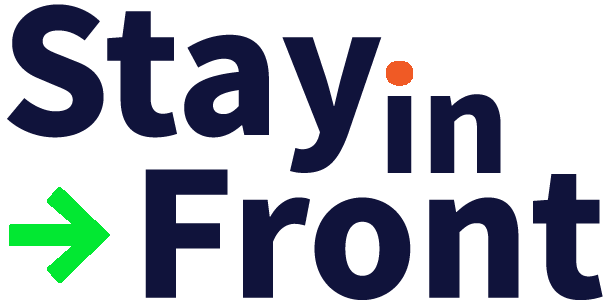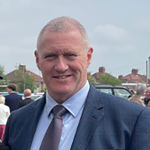
Derrick Jones
Commercial Director
StayinFront Retail Data Insight
Derrick has 20+ years of experience in senior roles in the CPG Industry, having worked with Mondelez International Inc., Kraft Foods, Cadbury International PLC, and HJ Heinz. Following progressive roles in Marketing, Sales, and Customer Service, he led teams responsible for inside sales support, including merchandising strategy and tools, sales planning, and retail execution systems and support.
Following Kraft’s acquisition of Cadbury, Derrick’s role in Canada as a Director was to lead sales key account and retail systems integration. Derrick then joined Mondelez as it separated from Kraft Foods. Shortly after, he led the support team for North America Retail Systems where he implemented StayinFront RDI in Canada which was chosen as the first market to implement a global big data sales analytics platform. After leaving Mondelez at the end of 2018, he joined a boutique consulting firm, assisted in the development of an AI-language analytics platform, took on a business development role for a technology client expanding to Canada, and engaged in a strategy consulting role with a not-for-profit organization supporting LGBTQ+ Diversity, Equity & Inclusion in the workplace. He engages with a holistic focus on both systems design and cultural readiness to deliver success as organizations stretch ahead to new ways of working enabled by leading technology solutions.

Derrick, you’ve devoted over 20 years to sales systems and analytics and specifically how to leverage data and technology for growth within consumer goods companies. What are some of the pain points you have seen organizations struggle with?


Three things come to mind right away.
First, the ability to demonstrate ROI of retail sales investments to the rest of the organization. Capital invested in factory equipment by contrast usually has a straightforward ROI, presuming all goes according to plan. But to unpack the drivers of growth and attribute fair share with confidence to retail sales activity has been a challenge. Marketing will claim it is the branding, advertising, and promotion. Key accounts will claim it is the joint business plan they negotiated with the customer. Until recently, we have had only anecdotal evidence such as call coverage, random display photos, and other such indirect assessment tools. This makes it tough for retail sales leaders to secure investment in new technologies that can really make a difference.
Secondly, the relentless pursuit of organizational efficiencies rather than investing in capabilities. Delayering, offshoring, and an overall reduction of resource challenge most CPG leaders to still deliver growth. Necessary as this may be, from a corporate lens, retail sales teams, with relatively large numbers of colleagues and a weaker ability to demonstrate their ROI, are subject to cost reduction pressures. But what happens is the organization, including sales leadership, loses touch with what is happening at retail. When I started in CPG, a district manager had 6-8 reps reporting to her. When I left, a district manager had, on average, over 15 reps on her team; and in addition, had lost HR support to a self-serve portal managed by offshore resources – I hesitate to even call them a support team. Guess what. That didn’t work very well. So how much time does that district manager have to ensure her reps are building relationships at retail, and honing their skills of influence? Are they calling on the right stores, with the right pitch targeting the right brands at the right time? How does she know what her reps accomplished in the store, and how those actions impact store-level sales? With so little 1:1 time with each rep, district managers and retail sales leaders rely more and more on numbers, like time in call, call coverage, maybe strike rate on booking orders; but these tell a very incomplete part of the story.
A third pain point builds on this further. How can we narrow the performance gap among our reps, enabling ALL reps to perform at a level very close to our top-performing reps? This becomes even tougher with less 1:1 coaching time from district and regional managers, incomplete performance metrics, and often a dated, or incomplete technology platform.

How have things changed in recent years?


The simple answer is technology and data have changed, but many retail organizations have not. Cloud technology, efficient APIs, well-constructed data architecture, image recognition technology, AI and machine learning, proven predictive models, and advanced visualization and reporting dashboards enable so much more now. Fit for purpose and SaaS tools can solve business pain points and demonstrate compelling ROIs. The speed of technology advancements continues to accelerate.

Expand on this a bit. How will these advancements in data and technology impact CPG Retail organizations?


To illustrate this, let us look at a hypothetical “day in the life” of a retail rep in a CPG organization fully engaged with a technology partner able to deliver solutions to these business pain points.
First, a hypothetical “day in the life” of a rep. During her morning prep, the rep will see her planned calls for the day, already informed by POS data, directing her to where she will have the greatest store-level impact.
Walking into her first store, she knows in advance of an OSA problem as $0 sales have been reported for 3 consecutive days on a planogrammed SKU. She takes a photo of the shelf section and is quickly informed where that SKU should be, and that the shelf tag is missing. A competitive product has an additional facing where her shelf tag should be. She also notices from the “on the spot” photo analytics that 2 of her best-selling SKUs are on a lower shelf than the agreed planogram.
Checking backroom stock, she sees extra inventory on four other SKUs that are no longer on-feature. Taking these issues up with the section manager, she identifies the OSA gap and asks that she print a new shelf tag to place on-shelf and asks that they order stock immediately. She identifies the excess backroom stock and offers to put up a small display, at full price, to clear this through. They agree. The rep takes a photo of the unplanned display as she leaves, records her activity in-store, and reminds store staff of next week’s promotions, sharing 3 quick screenshots on her tablet of the products and recommended displays. After recording her activity, her system will track uplift in POS sales on the OSA fix, the planogram compliance returning the two SKUs to their rightful shelf spot, and building the unscripted display. Her system will measure incremental POS sales taking into account the pre-visit 7-day baseline of her current store, and a matched sample of the same banner, similar size stores, serving as control group looking forward, to net out any promotional impact from the measure of incremental sales driven by her activity during the call. Her incremental sales impact is captured on her dashboard, showing both call and YTD impact of her actions, which she can also share with section and store managers to demonstrate value and further enable her ability to influence.

That’s a great explanation. So, what about a “day in the quarter” for sales leadership teams in CPG organizations?


During leadership business reviews Sales leaders will review their respective district, region, national, and account dashboards according to their roles to assess impacts. Quartile analytics will reveal such things as high growth and low growth stores vs account average, and which territories hold the highest and lowest percentage of high growth and low growth stores vs banner average. The incremental impact of rep activity will be visible by activity type such as closing OSA gaps, incremental displays, feature and display compliance, planogram compliance, and new item sales during the first 4 weeks of listing. Regional retail managers discuss with account teams what is working well (or not) at store level for their accounts and discuss with district managers what is working well (or not) at store level for their territories.
Performance metrics now focus on the successful impact of time in call. Machine learning and AI continue to enhance insights including factors such as top brand shelf location vs competitive SKUs, to understand if we gain (or lose) sales located close by a competitive SKU. Looking ahead to the 2nd half, retail sales leadership reviews the predictive territory optimization model to maximize focus on priority brands planogram and compliance, as media campaigns will soon break on several of these brands. In anticipation of some possible pressure on hitting revenue targets, they also assess incremental revenue opportunities if they were to contract a distributor for additional coverage of stores not in the regular call cycle. Even though they have no POS data for these stores, which is often the case with small independent stores, seasonal outlets, and developing markets. They find a predicted revenue opportunity of $2m, with a blitz coverage cost estimate of $150k from their distributor partner, providing just over 13:1 payback. They identify the “go no go” date needed to activate the activity and settle into H2 retail activation with confidence.

With all the exciting developments, why did you decide to leave a large global CPG company and ultimately join StayinFront?


I have a passion to lead transformational change where data, systems, and people intersect. The vast majority of CPG “day jobs” consume a lot of time “running the business”, which was certainly the case for me. I realized that real innovation is happening among SaaS service providers where the “day job” is to innovate, solve pain points, and create meaningful metrics and insights from data. Technology is moving way too fast for most large CPG companies to keep up with in-house development, or via large enterprise systems alone. Now, my “day job” is all about unleashing new capabilities to drive growth through technology and insight innovation. There is a very significant component of people involved with this work. How organizations measure success, workflow processes, policies, managing pilot roll-out, adopting “learning metrics”; and not just “performance metrics” are all part of ROI success.
I chose StayinFront specifically as I have first-hand experience using several of their tools while in CPG, and discovered even more innovation breaking through as we speak today. It is rare to find a technology partner so focused on driving growth through end-to-end solutions. They aren’t selling technology. StayinFront is selling growth through solutions that leverage technology and create insight innovation. This is a perfect fit for me. I am at my best working where people, technology, and data meet, looking holistically at how to drive success.

We read a lot about AI and machine learning, and you mentioned that in terms of things that have changed. How do they contribute to the space in the near and medium-term?


Sure, this is an interesting area. Most CPG companies spend a lot of time looking at NielsenIQ and customer POS data, and these are important sources, but left to human analysis alone, we fall short on insights and translating that into growth. Where AI and machine learning enter the picture, is in optimizing call planning; to be sure we call on the right store at the right time with a focus on the right brands, with the right insights to influence store level, all while managing to our total workload resource constraint. Machine learning is constantly working in the background, analyzing the impact of rep activity, planogram layout, and many other factors to refine how we guide our sales reps and to surface compelling insights which we simply cannot access through human analysis. For example, the point I mentioned about understanding sales impact of locating our SKUs close to competitive offerings – do we win or lose in that scenario. Some predictive models can even predict the value opportunity for stores never called on, and where we have no POS data, by looking at how certain known variables apply to stores we do call on, and where we do have data, then using those variables to predict potential. This “data lite” predictive modeling, driven by AI and machine learning, is ideal for developing markets and smaller independent outlets.

Digital transformation seems to be a catch-all phrase to some. What is it in your view, and how does it apply to retail sales?


I see digital transformation as the means through which we leverage data and technology to fully inform retail teams how to drive growth. It’s the right metrics and insights at the right time available on demand on any device of convenience. This is not about technology alone. Successful digital transformation is a new path to growth and requires a cultural readiness for success as much as it requires the technology to deliver it. New ways of learning, new ways of measuring success, and new ways of working at retail are all important to digital transformation.

Do you have any advice for CPG Leaders?


Sure. Engage this as a journey, not as a single project, with a partner who can do the work for you. It’s not going to work as an internal project. Find your most compelling pain point and use that as a toehold to start the journey with a pilot, using success and ROI to fuel the journey toward a fully empowered retail team.
Thank you Derrick for taking the time to share your thoughts with us today.
As the CEO of StayinFront, Tom Buckley is the driving force behind the company’s vision and growth and has built a team of top-flight managers and strategic alliances with key industry partners. With a vision of leveraging technology to solve business problems, Tom founded StayinFront in 2000. He has grown the company into a leading global provider of SaaS-based mobile field solutions in the life sciences and consumer goods industries with successful deployments in over 50 countries across six continents.


Thomas Buckley
Chief Executive Officer
StayinFront
RECENT INTERVIEWS


Subscribe To News & Updates
Quick Contact








